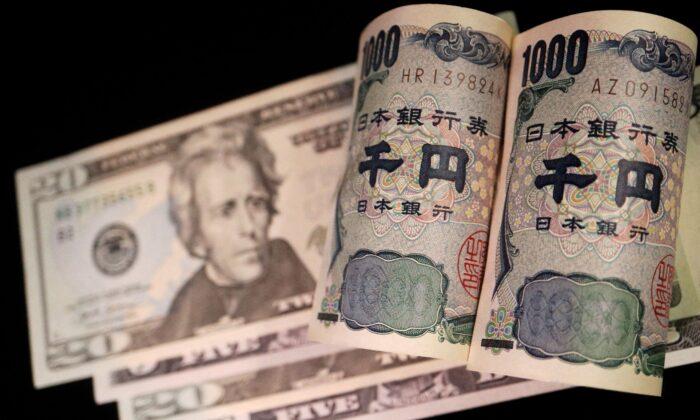The Japanese yen has weakened to its lowest level against the U.S. dollar since December 1986, raising speculation that the government might be forced to intervene again to prop up the currency and limit the damage from the sharp selloff.
The U.S. dollar/Japanese yen exchange rate widened during the June 26 trading session, to as low as 160.66 yen to the dollar. Year to date, the yen has slumped by nearly 14 percent against the greenback. Over the past three years, the Japanese currency has also lost about one-third of its value.
A weakening yen has raised import prices in Japan by nearly 7 percent in the past year, weighing on consumer finances and creating uncertainty for businesses.
Comments from the nation’s currency chief have bolstered expectations that Tokyo might take action to support the currency two months after the last round of intervention.
“I have serious concerns about the recent rapid weakening of the yen, and we are closely monitoring market trends with a high sense of urgency,” Japanese Vice Finance Minister Masato Kanda told reporters on June 26. “We will take necessary actions against any excessive movements.”
It’s unclear as to what level Japanese officials are waiting for to act to prop up the yen, says Ipek Ozkardeskaya, senior analyst at Swissquote Bank.
“The yen bears are testing the nerves of the Japanese officials to see what level will trigger an FX [foreign exchange] intervention,” she said in a note emailed to The Epoch Times.
Mr. Kanda’s remarks come days after suggesting Japanese officials would be ready to intervene in currency markets aggressively.
“If there are excessive currency fluctuations, it has a negative impact on the national economy,” Mr. Kanda said on June 20. “In the event of excessive moves based on speculation, we are prepared to take appropriate action.”
Japanese Chief Cabinet Secretary Yoshimasa Hayashi noted on June 25 that authorities would respond appropriately as the intense volatility in the foreign exchange rate has affected business and household demand.
It wouldn’t be the first time the government intervened in the currency markets.
After the yen slumped to a 34-year low against the dollar in late April, Japan spent more than $61 billion intervening in foreign exchange markets between April 29 and May 29. Authorities sold the yen and purchased other currencies, such as the U.S. dollar, to counteract the yen’s selloff and stabilize its value.
Reading the Yen Tea Leaves
The yen will likely remain around these low levels over the next six to 12 months, according to Michael Cahill, senior currency strategist in the Global Macro and Markets Research Group at Goldman Sachs.“The bottom line is that the macro-environment should continue to weigh on this safe-haven currency, and the Federal Reserve cuts (and BOJ hikes) that we expect probably won’t provide that much support,” Mr. Cahill said in an emailed note to The Epoch Times. “The yen could weaken further if the U.S. economy proves even more resilient than we expect, and if the Fed delivers even fewer rate cuts down the line.”
David Miller, co-founder, chief investment officer, and senior portfolio manager of Catalyst Funds, told The Epoch Times: “We are currently short the Japanese Yen vs. the US Dollar in our Catalyst Systematic Alpha Fund (ATRFX) given the extreme disparity between US rates and Japanese rates. The yen continues to tumble to multi-decade lows as the carry trade becomes very appealing. It is unlikely the Bank of Japan will intervene to trade the Yen until the US sees inflation rates drop.”

For the first time in 17 years, the Bank of Japan (BOJ) raised its key interest rate policy in March, from negative 0.1 percent to a range of zero percent to 0.1 percent.
Despite Japan’s rate hike, it hasn’t been enough to prevent investors from jumping into dollar-denominated assets.
While the Federal Reserve has signaled that it will cut interest rates in the near future as long as inflation pressures ease, the U.S. central bank anticipates keeping the benchmark federal funds rate higher for longer. According to the updated June Summary of Economic Projections, Fed officials have penciled in just one rate cut this year, lowering the median policy rate to 5.1 percent by the year’s end, from the current range of 5.25 percent to 5.5 percent.
The institution’s higher-for-longer narrative has kept U.S. Treasury yields elevated.
The benchmark 10-year yield topped 4.31 percent on June 26. The two-year yield firmed above 4.74 percent, while the 30-year bond surpassed 4.44 percent.
The relationship between the yen and the U.S. 10-year Treasury matters because a weakening Japanese currency could drive U.S. bond yields higher, Mr. Bianco said.
“The relationship between the yen and 10-year yield is not spurious,” he wrote on the social media platform. “Japan is the largest foreign owner of U.S. Treasurys, currently over $1 trillion, and much larger than China.”
The Japanese central bank has been debating whether to pull the trigger on another rate increase, with officials maintaining a data-dependent approach.
According to a June BOJ meeting summary, one monetary policymaker advocated for an increase “without too much delay” to prevent inflation from overshooting expectations.
“The BOJ must continue to closely monitor data leading up to the next policy meeting,” the official said. “If deemed appropriate, the BOJ should raise its policy rate without too much delay.”
Last month, Japan’s annual inflation rate rose to 2.8 percent, from 2.5 percent in April.
In addition, the BOJ’s second-quarter Tankan index of sentiment and outlook among large manufacturers will be released on July 2. This will also be a factor for officials’ next rate decision.
The next two-day BOJ policy meetings will occur on July 30–31.







